iPhone Paintings and Amazing Guitars
An animated video I painted and created using an iPhone and the amazing people I met during my life in Venice, Italy. Read On!
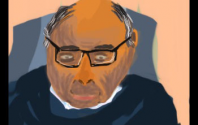
Figurative Italy
Popularized by the Italian culture, these impressionist, moment-to-moment paintings are truly a remarkable discovery. Inspired by the pure passion of beings around him, Tyler White has enveloped what we know, as social beings, to be true to our minds subconsciously and physically. Created with the popular iPhone application, “Brushes,” these individual representations of life indicate a true understanding of the context of human existence. Translating, using what tools we have, can change the world and make those around us smile. Read On!

What Is Existence Without Sound?
What would your world be without sound? Would the absence of all sounds (the incessant bustle of cars - the delicate buzz of flies over a bubbling river) change your emotional state of being? Can we understand our world more completely if we remove sound, all the while noticing the differential in our realities? Read On!

Bacterial Orchestra
An evolving cluster of aggressive, and possibly angry, iPhones wants to take over the world! The experiment is called “Public Epidemic No 1″ and the goal is to create a world-wide audio illness, infecting one cell at a time. Read On!
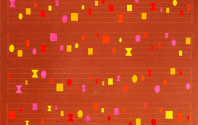
The Music of Paint: Odd Music Composed by Colors and Shapes
At first sight, Orlando Leibovitz’s paintings are quite shocking. With their high contrast lighting and warped color palette, the feelings evoked, for me, resemble post-apocalyptic life viewed through the sunglasses of the button-pusher himself. Sulk no more! Not all of Orlando’s paintings are heavyhearted. Read On!
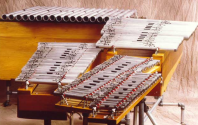
20 Very Odd Musical Instruments You Can Play Online
American Public Media has produced a playable-online collection of Harry Partch musical instrument inventions for your extreme enjoyment! Read On!
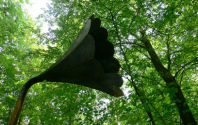
Score for a Hole in the Ground
Imagine yourself standing in the heart of a Medieval forest. A cool breeze blows around your body and the surrounding branches whisper secrets in your ears. You close your eyes for a moment and carefully listen, purposefully trying to focus your awareness on the most distant sounds. Read On!
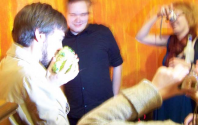
Vegetable Instruments, Baltimore, and the AVAM
I’m back in Santa Fe and I must say that the vegetable instrument workshop was a huge success! The American Visionary Art Museum gathered a bunch of us music folks together for an amazing day of junk instrument building, noise parties, instrument petting zoos, vegetable instruments, and discussions about music and the brain. Read On!
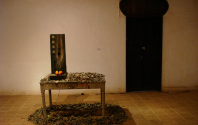
Soundscapes of Earth, Water, Fire, and Air
Emilio, from Chiapas, Mexico, sent in a home brew of some of his sound experiments. Four “soundscapes,” each one representing a different element (Earth, Fire, Air, and Water). These tracks are rich with texture and familiarity, especially “Fire,” which filled my thirsty ear with popcorn popping over an oscillating sea tide… Read On!

What Instrument Would Dr. Seuss Play? A Daxophone of Course!
Rarely does an instrument’s form match up with it’s sound as perfectly and whimsically as the daxophone’s. Invented by Hans Reichel of Germany, the daxophone is a friction idiophone who’s vibrating mechanism is an oddly but tactically shaped wooden tongue which is attached to a block of wood. The vibrations travel from the vibrating blade to the block where a contact microphone amplifies the sound. The whole concept is similar to plucking a ruler half-way off a table. Read On!
Telemegaphone Dale Update
The Telemegaphone Dale loudspeaker will continue to “speak” incoming phone calls until September 20th, 2008. For those of you who don’t know, Telemegaphone Dale is a 23-foot-tall wind-powered loudspeaker sculpture that picks up incoming calls and projects them into the mountains of Norway and the nearby village of Dale. Read On!
Experimental Listening: “Pillowsongs” by George Khut
We’ve all heard of experimental music, but what is experimental listening? George Khut, a Sydney based artist specializing in “body-focused interactive art systems” (e.g. biofeedback systems) is the creator of “Pillowsongs,” an installation exploring sleep and rest as a space for listening. Read On!
Pyrophones and Explosion Organs!
Pyrophones, also known as explosion/fire organs, are musical instruments which are sounded by explosions, fire, rapid combustion, rapid heating, and other thermoacoustic devices. The combustion occurs inside of the actual resonance chamber (the pipe). Fire organs are said to have been around since the 1700s! Read On!
Beethoven’s 9th Symphony x 22.15 = Very, Very Slow Classical Music
Leif Inge, an idea-based artist from Norway, stretched Ludwig van Beethoven’s Ninth Symphony to last 24 hours without any pitch distortion. “[The source music] lasts approximately 65 minutes, hence the applied expansion-factor is about 22.15.” This rendition, entitled ‘9 Beet Stretch,’ is unrecognizably slow, creating an entirely different mood than that of the iconic original. The magnified notes are pleasurable in the most cogitative way. Read On!
Listen to a Sunrise
Richard Widerberg from Göteborg, Sweden has some very odd and interesting sound recordings on his website including a track entitled “Sunrisescape” which makes use of light sensors and two oscillators to record the gradual illumination of a rising sun. Read On!
The Cristal Baschet (Crystal Organ)
The Cristal Baschet, also known as the crystal organ, sounds very much like it’s crystallophone similitude, the glass armonica. Both of these instruments are friction idiophones, that is they produce their sounds when their glass ‘keys’ (in this case, 54 chromatically tuned glass rods) are vibrated, usually by a wet finger. Read On!
Nick Cave’s Sound Suits
Nick Cave, an artist and educator working out of Chicago, is the creator of full body “soundsuits” which are made from layers of metal, plastic, fabric, hair, found objects, and other things that rub together to make noise. Many of Cave’s soundsuits are politically/socially inspired and have deeper meanings than just looking fantastic and making rustle sounds. Read On!
“Longest Concert Ever” Is Actually 1000 Years
The ringing sounds coming out of the lighthouse at Trinity Buoy Warf, London are blips from a 1,000-year-long opus. This millennial organism, entitled Longplayer, was born at midnight on the 31st of December 1999 and will (hopefully) continue living until that same moment in 2999. The Longplayer can be heard from various listening posts around the world and via a live audio stream (which I suggest you plug into now while reading the rest of the article). Read On!
Bill G. Loyd’s Giant Wind Bells
Browsing through Madrid, New Mexico today, I stumbled across some wonderful wind bells/gongs on display at the Range West gallery. These bells, made by the Truchas, NM artist Bill G. Loyd, are cut from recycled gas tanks (e.g. scuba tanks, CO2 canisters, O2 firefighter tanks, etc.). Read On!
An Arsenal of Oddstruments
Ken Butler’s “hybrid instruments” - Axe, crossbow, and assault rifle violins? Shovel tablas, easel guitars, umbrella igils, and toothbrush violas? Oh my! Watch Ken put a mic in his mouth and play his entire face! Read On!
The Longest Concert Ever Has Reached Its 6th Note!
The slowest piece of music ever is currently being played in the church of St. Burchardi in Halberstadt, Germany. John Cage’s project is called ORGAN2/ASLSP (for ‘as slow as possible’). It began in 2000 and has just reached it’s sixth note! Read On!
Playing the US/Mexico Border With Instruments of Mass Percussion
An interesting sound project by Glenn Weyant: “The Anta Project is a series of recordings blended in a multi-track laptop environment to create a single sonic collage of the U.S./Mexico border near Nogales, Arizona.” Read On!
How to Play a Building
If you haven’t heard about this already, it’s a pretty cool idea. Basically, David Byrne attached a bunch of lopsided motors and solenoids to the structural steel in an old ferry station/slaughter house in New York City. The motors/solenoids, controlled by a recycled organ, vibrate/strike different elements of the building such as pipes, radiators, girders, columns, and beams! No amplification was used in the project; just the natural resonance of the building itself. Read On!
Call This Number! Odd Instrument Telephone Speaker
Call +4790369389 to have your voice blasted into the luscious lands of Norway! Telemegaphone Dale is a 23-foot-tall wind-powered loudspeaker sculpture that picks up incoming calls and projects them into the nearby surroundings. This Telemegaphone, created by the Swedish designers at Unsworn Industries, is located on a mountain overlooking the village of Dalsfjord in Western Norway. Apparently, a “massive” amount of people have been calling. Read On!
Mike Evans’ Spiral Instrument
Mike Evans is an incredible sculptor in Santa Fe and this is one of his more abstract works. Read On!
Double Horn Pipe by Wouter Baeck
From Wouter Baeck, an amazing musician, sculptor, painter, and musical instrument creator. “An ancient instrument came to live. Based on a thin long straight bamboo reed tied up with a thread on a small bamboo mouth piece. Protected by a gourd. Double pipe made out of bamboo or elder wood, and always with an animal horn as resonator.” Read On!
Robert Fludd’s Musical Instrument Illustrations
These ingenious illustrations are from the book De Naturae Simia written by the very controversial physicist, astrologer, philosopher, and mystic Robert Fludd (1574-1637) who was first to discuss the concept of blood circulation. Maybe this is why so many of his instruments seem to involve hydraulics. Read On!
